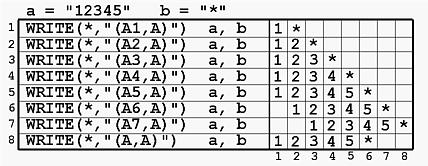- If w is larger than the length of the
character string, all characters of the string can be
printed and are
right-justified.
Also, leading spaces will be added.
The following example prints the string "12345"
of length 5 (i.e., five characters) using
A6.
Since w is larger than the length of the string, all five characters are printed and right-justified. The result is shown below:WRITE(*,'(A6)') "12345"

- If w is less than the length of the
character string, then the string is
truncated and only the
left-most w positions are printed in the
w positions.
The following example prints the string
"12345678" of length 8 (i.e., eight
characters) using A6.
Since w is less than the length of the string, only the first six characters are printed. The result is shown below:WRITE(*,'(A6)') "12345678"

- If w is equal to the length of the character string, then it is an exact match. All characters can be printed and all w positions are filled.
- If w is missing (i.e., edit
descriptor A), then the
value of w is assumed to be the length of
the string. The following example shows two
WRITE statements. The first one uses A to
print a, a string of length 5. The second
one also uses A to print b, a string of
length 2.
Since the A edit descriptor will use the length of the string as the value of w, the above is equivalent to the following:CHARACTER(LEN=5) :: a = "abcde" CHARACTER(LEN=2) :: b = "MI" WRITE(*,'(A)') a WRITE(*,'(A)') b
Therefore, the A edit descriptor is more convenient than Aw.CHARACTER(LEN=5) :: a = "abcde" CHARACTER(LEN=2) :: b = "MI" WRITE(*,'(A5)') a WRITE(*,'(A2)') b
it is equivalent toCHARACTER(LEN=5) :: a = "123" CHARACTER :: b = "*" WRITE(*,"(A,A)") a, b
and the result isCHARACTER(LEN=5) :: a = "123" CHARACTER :: b = "*" WRITE(*,"(A5,A1)") a, b

The first string, a, is of length 5 and hence the first five positions are used. Why are two extra spaces when the string is written as a = "123"? Since the length of a is five and "123" has only three characters, two spaces are added to the right end to make up five characters. Therefore, variable a actually contains five characters: 1, 2, 3 and two spaces. This is why two spaces are between 123 and * in the above output.
